SERION ELISA classic Measles Virus IgG/IgM
SERION ELISA classic Measles Virus IgG/IgM
SERION ELISA classic Measles Virus IgG/IgM
- No tags were found...
Create successful ePaper yourself
Turn your PDF publications into a flip-book with our unique Google optimized e-Paper software.
5. MATERIAL REQUIRED BUT NOT SUPPLIED- common laboratory equipment- for the <strong>IgM</strong>-<strong>ELISA</strong>: special <strong>SERION</strong> Rf-Absorbent with control antigen(Rf-absorbent CAg, order no. T 200, 20ml)- photometer for microtiter plates with filter, wave length 405 nm, recommendedreference wave length 620 nm - 690 nm (e.g. 650 nm)- incubator 37°C- moist chamber- distilled water6. STORAGE AND STABILITYReagent Storage Stabilitymicrotiter strips(antigen)control sera /standard seraconjugatedilution bufferwashing solutionafter opening at 2-8°C in closed aluminum bag withdesiccantStrips which are not used must be stored in the press-seal bagof aluminum compound foil under dry and airtightconditions!after opening at 2-8°Cready-to-use solution, at 2-8°CAvoid contamination (sterile tips!)after opening at 2-8°CDiscard cloudy solutions!unopenedconcentrate after opening at 2-8°Cworking dilution at 2-8°Cworking dilution at room temperatureBottles used for the working dilution should be cleanedregularly, discard cloudy solutions.4 weeksuntil expiry date;24 months fromdate of productionuntil expiry date28 months fromdate of production24 monthsuntil expiry date;36 months fromdate of productionuntil expiry date2 weeks1 weeksubstrateready-to-use solution at 2-8°C, protected from light!Avoid contamination (sterile tips!) Discard when solutionuntil expiry date24 months fromdate of productionturns yellow (extinction against distilled water > 0.25).stopping solution after opening at room temperature until expiry dateenglish 5
7. TEST PROCEDURE <strong>SERION</strong> <strong>ELISA</strong> <strong>classic</strong>7.1 Evidence of deteriorationOnly use <strong>SERION</strong> <strong>ELISA</strong> <strong>classic</strong> reagents for test procedure, since all reagents are matched.In particular standard and control sera are defined exclusively for the test kit to be used. Donot use them in other lots. Dilution buffer, washing solution and substrate solution can beused for all <strong>SERION</strong> <strong>ELISA</strong> <strong>classic</strong> kits irrespective of the lot and the test.There are three different conjugate concentrations for each immunoglobulin class: LOW,MEDIUM, HIGHThe classification is written on each label as follows:e.g.<strong>IgG</strong> + lowly concentrated <strong>IgG</strong> conjugate<strong>IgG</strong> ++ medium concentrated <strong>IgG</strong> conjugate<strong>IgG</strong> +++ highly concentrated <strong>IgG</strong> conjugateIn rare cases the use of special conjugate is necessary to guarantee consistent quality for ourproducts. Special conjugates are produced in a separate lot and do not wear the “+” sign.Therefore, special conjugates are not exchangeable with other conjugates.Please pay close attention to notifications on labels!Unopened, all components of the <strong>SERION</strong> <strong>ELISA</strong> <strong>classic</strong> kits may be used up to the datesgiven on the labels, if stored at +2°C to +8°C. Complete stability and storage data aredescribed under “6. Storage and Stability”.Each reagent has been calibrated and optimized for the test. Dilution or alteration of thesereagents may result in a loss of sensitivity.Avoid exposure of reagents to strong light during storage and incubation. Reagents mustbe tightly closed to avoid evaporation and contamination with microorganisms sinceincorrect test results could occur due to interference from proteolytic enzymes.To open the press-seal bag please cut off the top of the marked side, only. Do not use thestrips if the aluminum bag is damaged or if the press-seal bag with remaining strips anddesiccant was not properly closed.Bring all reagents to room temperature before testing.Use aseptic techniques for removing aliquots from the reagent tubes to avoidcontamination. To avoid false positive results ensure not to contact or sprinkle the top-wallsof wells while pipetting conjugate. Take care not to mix the caps of the bottles and/or vials.Reproducibility depends on thorough mixing of the reagents. Shake the flasks containingcontrol sera before use and also all samples after dilution (e.g. by using a monomixer).Be sure to pipette carefully and comply with the given incubation times and temperatures.Significant time differences between pipetting the first and last well of the microtiter platewhen filling samples/control sera, conjugate or substrate may result in differentenglish 6
“pre incubation” times, which may influence the precision and reproducibility of theresults.Optimum results can only be achieved if <strong>SERION</strong> <strong>ELISA</strong> <strong>classic</strong> instructions are followedstrictly.The test is not valid, if the lot-specific validation criteria on the quality control certifcate arenot fulfilled.Inadequate washing will affect the test results:The washing procedure should be carried out carefully. If the washing procedure is carriedout automatically follow the instruction manual of the respective washer. Flat bottom wellsare used for <strong>SERION</strong> <strong>ELISA</strong> <strong>classic</strong>. All wells should be filled with equal volumes ofwashing buffer. At the end of the procedure ensure that the wells are free of all washingbuffer by tapping the inverted microtest plate on a paper towel. Avoid foam! Do not scratchcoated wells during washing and aspiration. If using an automated washer, ensure it isoperating correctly.7.2 Sample preparation and storageLipaemic, hemolytic or icteric samples should only be tested with reservations although inour testing no negative influence has been found. Obviously contaminated samples (serumor plasma) should not be tested due to the risk of wrong results.Serum, plasma (EDTA, citrate, heparin) or CSF collected according to standard laboratorymethods are suitable samples.Samples must not be thermally inactivated.7.2.1 Sample preparationBefore running the test, samples must be diluted in dilution buffer (V 1 + V 2) as follows:<strong>SERION</strong> <strong>ELISA</strong> <strong>classic</strong> <strong>Measles</strong> <strong>Virus</strong> <strong>IgG</strong>V 1 + V 2 = 1 + 100 add 10 µl sampleeach to 1000 µl dilution bufferAfter dilution and before pipetting into the microtiter plate the samples must be mixedthoroughly to prepare a homogenous solution.<strong>SERION</strong> <strong>ELISA</strong> <strong>classic</strong> <strong>Measles</strong> <strong>Virus</strong> <strong>IgM</strong>Rheumatoid factors are autoantibodies mainly of the <strong>IgM</strong>-class, which preferably bind to<strong>IgG</strong>-immune-complexes. The presence of non-specific <strong>IgM</strong>-antibodies (rheumatoid factors)can lead to false-positive results in the <strong>IgM</strong>-assay. Furthermore, the possibility exists, thatenglish 7
7.3 Preparation of kit reagents7.3.1 Microtest stripsMicrotest strips in frame are packed with desiccant in an aluminum bag. Takeunrequired cavities out of the frame and put them back into the press-seal bag. Closepress-seal bag carefully to ensure airtight conditions.7.3.2 Control sera / standard seraControl and standard sera are ready-to-use and must not be diluted any further. Theycan be used directly for the test run.For each test run and for each test system - independent of the number of microteststrips to be used - positive control and standard sera should be included. The cut-offcontrolshould be set up in duplicate. With the quantitative tests the standard serumshould also be set up in duplicate.Do not treat control sera with Rf-absorbent.7.3.3 Anti-human-<strong>IgG</strong>-, <strong>IgM</strong>- or IgA-AP-conjugate (ready-to-use)Please do not mix up conjugates from different kits. They are optimized for each lot.Conjugates are exchangeable as described in 7.1.Avoid contamination of ready-to-use conjugates (please pour sufficient for test into asecondary container to avoid repeatedly pipetting from the original bottle).7.3.4 Washing solutionDilute washing buffer concentrate (V 1) 1:30 with distilled water to a final volume ofV 2.Example:buffer concentrate (V 1) final volume (V 2)33.3 ml 1000 ml1 ml 30 ml7.3.5 Dilution buffer for samples (ready-to-use)7.3.6 Substrate (ready-to-use)To avoid contamination use gloves. For pipetting substrate solution use sterile tipsonly!7.3.7 Stopping solution (ready-to-use)english 9
7.4 Overview - test procedure<strong>Measles</strong> <strong>Virus</strong><strong>IgG</strong>/<strong>IgM</strong> quantitativein case of <strong>IgM</strong>-detection absorption of rheumatoid factor, see No. 7.2.1;incubation 15 minutes at room temperature or over night at 4°Csample dilution1 + 100Pipette diluted samples and ready-to-use control sera /standard sera into the microtest wells (100 µl)INCUBATION 60 min./ 37°Cmoist chamberWASHPipette conjugate solution (100 µl)INCUBATION 30 min./ 37°Cmoist chamberWASHPipette substrate solution (100 µl)INCUBATION 30 min./ 37°Cmoist chamberPipette stopping solution (100 µl)READ EXTINCTION AT 405 nmenglish 10
7.5 Test procedure1. Place the required number of cavities in the frame and prepare a protocol sheet.2. Add each 100 µl of diluted sample or ready-to-use controls into the appropriate wellsof microtest strips. Spare one well for substrate blank, e.g.:<strong>IgG</strong>/<strong>IgM</strong> quantitativeantigen cavitieswell A1 substrate blankwell B1 negative controlwell C1 standard serumwell D1 standard serumwell E1 sample 1....3. Sample incubation for 60 minutes (+/- 5 min) at 37°C (+/- 1°C) in moist chamber4. After incubation wash all wells with washing solution (by automated washer ormanually):- aspirate or shake out the incubation solution- fill each well with 300 µl washing solution- aspirate or shake out the washing buffer- repeat the washing procedure 3 times (altogether 4 times!)- dry by tapping the microtest plate on a paper towel5. Addition of conjugateAdd 100 µl of <strong>IgG</strong>-/<strong>IgM</strong>-/IgA-conjugate (ready-to-use) to the appropriate well (exceptsubstrate blank)6. Conjugate incubation for 30 minutes (+/- 1 min) * at 37°C (+/- 1°C) in moist chamber.7. After incubation wash all wells with washing solution (see above)8. Addition of substrateAdd 100 µl substrate solution (ready-to-use) to each well (including well for substrateblank!)9. Substrate incubation for 30 minutes (+/- 1 min) * at 37°C (+/- 1°C) in moist chamber.10. Stopping of the reactionAdd 100 µl stopping solution to each well, shake microtest plate gently to mix.11. Read optical densityRead OD within 60 minutes at 405 nm against substrate blank, reference wave lengthbetween 620 nm and 690 nm (e.g. 650 nm).* Please note, that under special working-conditions internal-laboratory adaptations of the incubation timescould be necessary.english 11
8. TEST EVALUATION<strong>SERION</strong> <strong>ELISA</strong> <strong>classic</strong> <strong>Measles</strong> <strong>Virus</strong> <strong>IgG</strong> and <strong>IgM</strong> (quantitative)8.1 Single-point quantification with the 4PL methodOptimized assignment of extinction signals to quantitative values is guaranteed by usingnon-linear functions, which adjust a sigmoide curve without any further transformation toOD-values.Determination of antibody concentrations with the <strong>SERION</strong> <strong>ELISA</strong> <strong>classic</strong> is carried out bythe logistic-log-model (4 PL; 4 parameter) which is ideal for exact curve-fitting. It is basedon the formula:OD = A +1 + eD - AB(C -ln conc.)The parameters A, B, C, and D are representative for the exact shape of the curve:1. lower asymptote parameter A2. slope of the curve parameter B3. turning point parameter C4. upper asymptote parameter DFor each lot the standard curve is evaluated by Institut Virion\Serion GmbH (Würzburg,Germany) in several repeated test runs under optimal conditions. Time consuming and costintensive construction of the standard curve by the user is not necessary.For evaluation of antibody concentrations a lot specific standard curve as well as a lotspecific evaluation table is included with each test kit. Appropriate evaluation software isavailable on request.To compensate for normal test variations and also for test run control a standard serum isused in each individual test run. For this control serum a ‘’reference value’’ with a validityrange is determined by the quality control of the producer. Within this range a correctquantification of antibody concentration is ensured. Since the standard serum is notnecessarily a positive control, the value of the standard serum may be borderline ornegative in some <strong>ELISA</strong> tests.8.2 Criteria of validity- the substrate blank must be OD < 0.25- the negative control must be negative- quantitative <strong>ELISA</strong>: the mean OD-value of the standard serum must be within thevalidity range, which is given on the lot specific quality control certificate of the kit(after subtraction of the substrate blank!)english 12
- qualitative <strong>ELISA</strong>: the mean OD-value of the positive control must be within thevalidity range, which is given on the lot specific quality control certificate of the kit(after subtraction of the substrate blank!)- the variation of OD-values may not be higher than 20%.If these criteria are not met, the test is not valid and must be repeated.8.3 Calculation <strong>SERION</strong> <strong>ELISA</strong> <strong>classic</strong> <strong>Measles</strong> <strong>Virus</strong> <strong>IgG</strong>/<strong>IgM</strong> (quantitative)8.3.1 Non-automated evaluationFor the test evaluation a standard curve and an evaluation table are included in the test kitso that the obtained OD-values may be assigned to the corresponding antibody activity.The reference value and the validity range of the standard serum is given on the evaluationtable (quality control certificate).The blank (A1) must be subtracted from all OD-values prior to the evaluation.Method 1: Qualitative evaluationTo fix the cut-off ranges please multiply the mean value of the measured standard-OD withthe numerical data of the certificate of quality control (see special case formulas), e.g.:OD = 0.502 x MW (STD) with upper cut-offOD = 0.352 x MW (STD) with lower cut-offIf the measured mean absorbance value of the standard serum is 0.64, the range of the cutoffis in between 0.225-0.321.Method 2: Continuous determination of antibody activities using the standard curve.So called interassay variations (day to day deviations and laboratory to laboratorydeviations) are compensated by multiplication of the current measured value obtained witha sample with the correction factor F. This factor is calculated as follows:F =OD-reference value (of standard serum)OD-current value (of standard serums)The procedure is necessary to adjust the current level of the test of the user with the lotspecificstandard curve.First, daily deviations are to be corrected by calculating a factor (correction factor F):1. The mean of the two OD-values of the standard serum has to be calculated and checkedthat it is within the given validity range.2. Calculation of the factor "F": the given reference value is divided by the mean of theextinction of the standard serum:F = reference value extinction standard serum / mean value extinction standard serum.3. All measured values of samples are multiplied by "F".english 13
4. Antibody activities in U/ml or IU/ml can be determined from the standard curve withthe corrected values.8.3.2 Automatic test evaluation with<strong>SERION</strong> easy base 4PL-Software/<strong>SERION</strong> evaluate-SoftwareAfter input of the 4 parameters and the reference value of the standard serum, antibodyactivities are calculated online. If the optical density of the standard is out of the validrange, the following message will appear:<strong>SERION</strong> easy base 4PL-Software:”Standards are not in tolerance range” and/or “Distance between standards is greaterthan 20 %.”<strong>SERION</strong> evaluate-Software:“Standard values out of ranges in following groups: Group 1-24. Standard value differmore than 20% in following groups: Group 1-24.”In these cases the test run is invalid and should be repeated.Parameters and reference value need to be changed only if there is a change of lot(evaluation table shows parameters and reference values). Correct input of the lot specificdata can be checked on the basis of the IU/ml or U/ml assigned to the standard serum. Thecalculated mean value of the units has to correspond to the unit value indicated on the lotspecific certificate.english 14
There is an automatic correction of the measured values. In the standard version theprintout displays the following:sample codeOD-valueIU/ml or U/mlevaluationenglish 15
9. STATEMENTS OF WARNING9.1 Statements of warningThe <strong>SERION</strong> <strong>ELISA</strong> <strong>classic</strong> is only designed for qualified personnel who are familiar withgood laboratory practice.All kit reagents and human specimens should be handled carefully, using established goodlaboratory practice.- This kit contains human blood components. Although all control- and cut-off-sera havebeen tested and found negative for HBs-Ag-, HCV- and HIV-antibodies, they should beconsidered potentially infectious.- Do not pipette by mouth.- Do not smoke, eat or drink in areas in which specimens or kit reagents are handled.- Wear disposable gloves, laboratory coat and safety glasses while handling kit reagentsor specimens. Wash hands thoroughly afterwards.- Samples and other potentially infectious material should be decontaminated after thetest run.- Reagents should be stored safely and be unaccessible to unauthorized access e.g.children.- Stopping solution: corrosive (C); causes acid burn (R34)use safety glasses, gloves and laboratory coat while handling!9.2 DisposalPlease observe the relevant statutory requirements!10. BIBLIOGRAPHYenglish 16



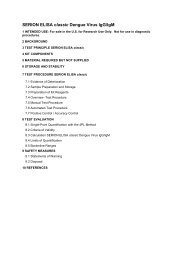
![MIKROGEN recomBlot CMV IgG [Avidity] recomBlot CMV IgM ...](https://img.yumpu.com/47840028/1/185x260/mikrogen-recomblot-cmv-igg-avidity-recomblot-cmv-igm-.jpg?quality=85)
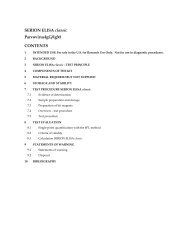
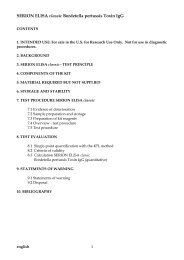
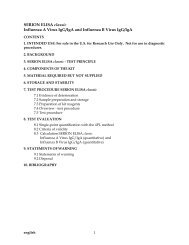

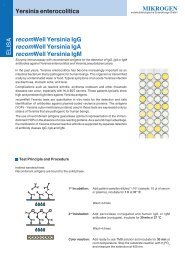
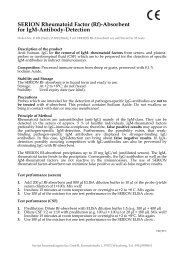

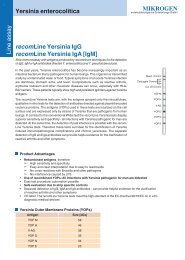
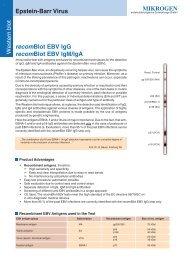
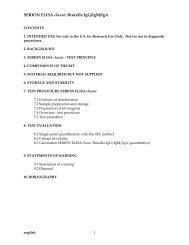

![MIKROGEN recomLine Parvovirus B19 IgG [Avidity] recomLine ...](https://img.yumpu.com/31102785/1/185x260/mikrogen-recomline-parvovirus-b19-igg-avidity-recomline-.jpg?quality=85)